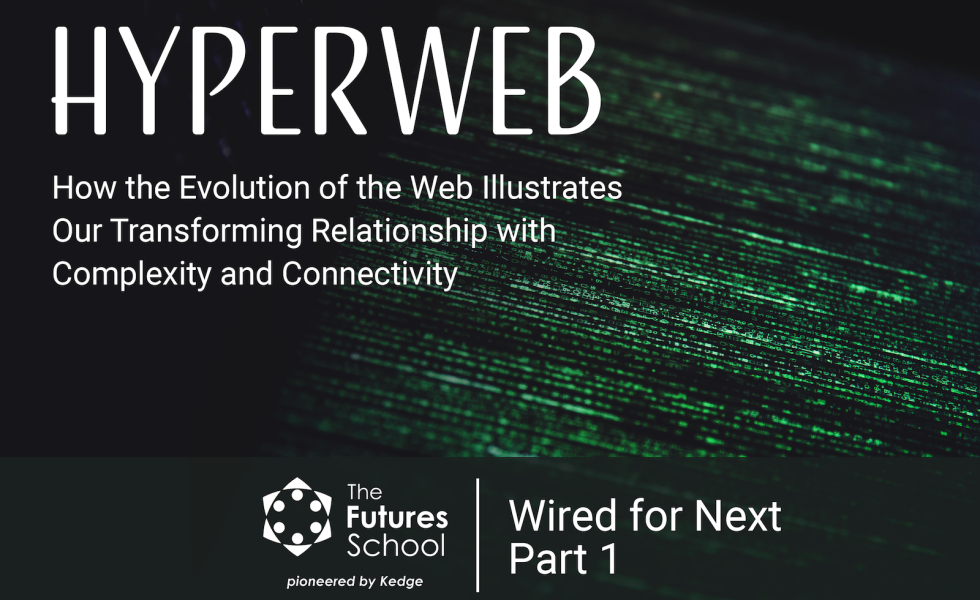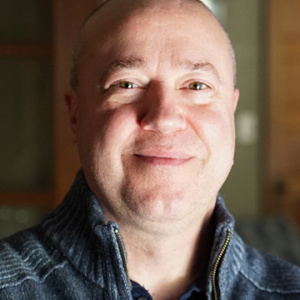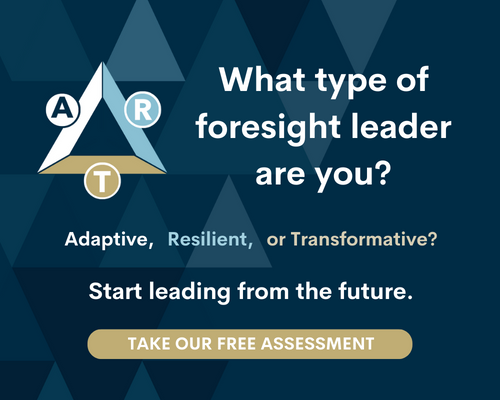Hyperweb: Wired For Next Part 1

The Wired For Next series looks at the deepening relationship between technology and humanity, and how that co-evolutionary relationship is changing the way that we approach the future of work, consumption, connection, food, play, learning, health, governance, transportation, organizational development, and so much more.
In 1973, renowned design theorist and university professor Horst Rittel penned a treatise on an original concept that he called wicked problems. According to Rittel, a wicked problem differs from a regular problem in that the former is extremely difficult – or sometimes impossible – to solve due to its changing and complex nature. Rittel’s use of the word “wicked” does not refer to being evil, but rather signifies the complex convergence and interaction of various ideas, issues, and agents that create extreme resistance to resolution. Each solution created for a wicked problem only reveals or creates more problems. In our environment of complex dilemmas in food economies, shifting concepts in work and education, technological disruption, economic distribution and disparities, shrinking job markets, political upheaval, class disenfranchisement, environmental collapse, and resource wars, almost every single issue has become a systemic and interconnected predicament with no obvious solution.
Most would agree that we now live in a world full of wicked problems, and our leaders are desperately seeking to find meaning in the midst of increasing complexity. Does our current way of thinking about these wicked problems – one that was developed in an era when siloed disciplines, linear planning processes, and risk management tools ruled the roost – help us tackle a landscape where exponentially accelerating complexity is the new norm?
Our Industrial Age relationship with complexity was adversarial, to say the least. Organizational and economic gurus positioned complexity as the enemy of efficiency, and suggested various ways to simplify, avoid, or even kill it. However, in this new environment, such advice is similar to suggesting that we stop breathing in order to avoid the flu. One of the first things we tell our clients is that if they attempt to kill complexity in order to successfully navigate their way forward, they might as well quit doing business altogether. Whether building companies, steering governments, or achieving personal goals, attempting to avoid complexity isn’t the answer anymore. Rather, just the opposite is true.
We must recognize that the rapidly changing landscape isn’t the real enemy of being empowered for the present and the future; it’s actually our outdated mental maps rooted in a previous stage of our development. What we need now isn’t better teaching on mindsets that were successful in a bygone economy. We need to shift our models.
Instead of operating out of fear, leaders must harness, embrace, and leverage increasing complexity as a matrix from which to realize new ideas, new services, and new solutions. When we adopt this view, we will begin to realize that complexity is actually the catalyst for the new discoveries that can solve age-old problems. In this new world of rapid change, we must learn to “dance with complexity” rather than attempt to kill it.
Think about this: when we mature from infant to teenager and ultimately adulthood, we transition from simplicity to greater complexity. When scientists and explorers look through their telescopes across the vastness of the universe, they see increasing levels of complexity rather than greater simplicity. Nature – in all of its manifestations – transitions from simplicity to complexity in order to achieve growth. Despite the tremendous problems we face, our world of expanding complexity is not a sign that we are collapsing, but is really an indication that we are growing.
Even though many professional and academic voices are beginning to sing the praises of embracing complexity for unparalleled growth, decades of vilifying this emerging condition have made popularizing it extremely difficult. However, such resistance is normal, because old systems don’t give way to new systems without putting up a fight. Like humans themselves, growth is a living, breathing, and organic process, and is in turn often a very messy experience. As we make our journey from the mechanical and reductionistic practices of the Industrial Age to what many are now referring to as a Postnormal Age full of radical disruption and change, we can expect that transition to be just as messy as when a teenager struggles to become an independent and mature adult. However, with the right mindset and response, we have the possibility of transitioning into a new vista of abundance.
So, how does increasing complexity actually lead to a generative world?
Researchers and professionals are noting that complexity is the seedbed of unlimited human creativity. Knowing how to harness and leverage complexity can lead us to new perspectives around our grand challenges, and help us to reach our goals. Much like an ever-growing canvas, accelerating complexity is giving us more space on which to paint an unending series of unique masterpieces.
INSEAD emeritus professor of organizational behavior Linda Brimm reinforces the idea that complex environments lead to greater creativity when she says,
Some respond by seeking simplicity and, as a result, either revert to the stable status quo (which stunts growth) or ignore problematic aspects of the change to make the decision easier (but not necessarily wiser). Both coping mechanisms are counterproductive. To kick off a successful change effort, you must embrace its complex dynamics.
Jennifer Gidley – educator, postformal psychologist and president of the World Future Studies Federation – agrees that complexity is a critical element in creativity. In addressing the need for increased practices of wisdom in 21st Century educational models, Gidley notes,
Wisdom is creative, complex, and integrative. Wisdom does not follow the straight and narrow, but meanders, pauses, plays with multiple options and looks around corners—curious for surprises… Multi-modal approaches to learning are very important in developing the multiple perspectives needed for wisdom to grow—as are some surprising and unexpected concepts… Wisdom is about waking up to multiplicity. Waking up—to our own presence and the presence of others. The complex wisdom embedded in the art of education demands being awake in every moment.
As we often tell leaders, harboring a culture of “creative complexity” in their organizations happens when we promote intentionally serendipitous interactions through diversity and collaboration.
The importance of diversity in relation to creativity and complexity is discussed by Northern Arizona University Professor of Science Education Jeffrey W. Bloom. As a contributor to the book A Critique of Creativity and Complexity, he stresses the critical nature of diversity in giving rise to complex systems that in turn foster creative ideas and possibilities.
In all cases, creativity is evident when ideas interact, change, and give rise to new ideas. Without diversity, the emergence of new ideas, new forms, new species is greatly limited. Without diversity, adapting and adjusting to new conditions are hindered or prevented. Without diversity, complex systems have no material for change. (p. 202)
As Columbia University Business School senior vice dean Katherine W. Phillips states,
The fact is that if you want to build teams or organizations capable of innovating, you need diversity. Diversity enhances creativity. It encourages the search for novel information and perspectives, leading to better decision making and problem solving. Diversity can improve the bottom line of companies and lead to unfettered discoveries and breakthrough innovations. Even simply being exposed to diversity can change the way you think. This is not just wishful thinking: it is the conclusion I draw from decades of research from organizational scientists, psychologists, sociologists, economists and demographers.
A perfect example of complexity’s exponentially-expanding role in cultivating creativity across the drivers of technology, society, and culture is the ongoing development of the World Wide Web. Created in 1989 by computer scientist Sir Tim Berners-Lee as a means for people to connect across the Internet, the World Wide Web is now used by approximately 3.5 billion individuals on a weekly basis as a means to conduct business, access education, and purchase everything from household goods to personal entertainment. Looking beyond these extremely profound but basic functions, Berners-Lee saw a much greater use for the web than simply being an information highway for the masses. Addressing the deeper purpose and potential of the web, he famously stated in modern-day prophetic language,
The Web as I envisaged it, we still have not seen it yet. The future is still so much bigger than the past.
With each passing day, this quote becomes more and more prescient. Today, most of humanity cannot fathom the potentially profound changes that are at our doorstep through web-related advancements such as:
- The Internet of Things – the ever-growing network of cars, homes, office buildings, furniture, clothing, and every other physical object you can imagine, all-connected and speaking to one another through the use of sensors, software, and smart technology
- Machine Learning and Artificial Intelligence – the ability for computers to learn without being manually programmed through the use of pattern recognition, predictive analytics, and complex algorithms, as well as a whole host of sentient technologies and cognitive models that impact consumption, education, online search, digital assistants, drones and self-driving vehicles
- Computer-to-Brain Interfaces and Intelligent Amplification – the direct communication between an enhanced or augmented human brain and any external computational device, including the use of information technology, neuroprothetics, cybernetics, and genetic engineering
Even if Berners-Lee’s quote about the long-term potential of the web was made without any knowledge of these emerging technological and human developments that have a direct connection to the evolution of the internet, one concept that he might have been visualizing was the idea of a “global brain” that was popularized in the early 20th century by the French philosopher Pierre Teilhard de Chardin.
Expounding on the works of French philosopher Édouard Le Roy and famed Russian scientist Vladimir Vernadsky, Chardin perceived that the entire universe matures through greater complexity, which in turn produces increased consciousness and burgeoning creativity. He reinforced this idea through his work on the “noosphere” – the emergence of a sphere of thought that connects all human minds and encircles the entire earth. The rapid acceleration of cyberspace and digital worlds has advanced this sphere of complex thought, fostering a huge jump in the intentional evolution of humanity. In this sense, Berners-Lee’s world wide web has become an integral element in the rise of a “global brain” and one of the greatest inventions in human history.
In the next installment of Wired For Next, we will be talking about the rise of Sobotics (social robotics) and its impact on business and society.

Frank Spencer
Co-Founder
Creative Director
In 2009, Frank founded Kedge – a global foresight, innovation, and strategic design firm which pioneered TFSX. Throughout his career, Frank has worked as a leadership coach and developer with entrepreneurs, social communities, networking initiatives, and SMEs, helping them in areas such as development, innovation, and networking.
Read More
